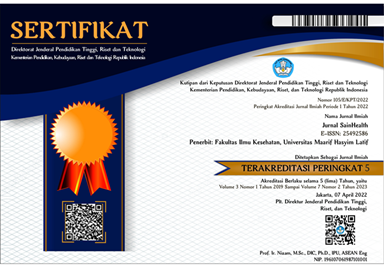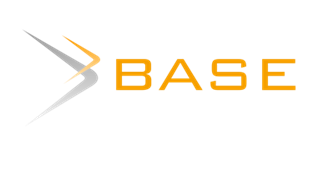PERBANDINGAN HASIL PEMERIKSAAN HBA1C METODE BORONATE AFFINITY DAN NEPHELOMETRY PHOTOMETRY
COMPARISON OF HBA1C EXAMINATION RESULTS BY BORONATE AFFINITY METHOD AND NEPHELOMETRY PHOTOMETRY
DOI:
https://doi.org/10.51804/jsh.v8i1.16509.15-19Keywords:
HbA1C, Boronate Affinity, Nephelometry PhotometryAbstract
HbA1C is glycosylated hemoglobin at the N-terminal group, HbA1C is hemoglobin with a minor component closely related to blood glucose. HbA1C is referred to as the breakdown of sugar in the body's metabolism or glycosylated hemoglobin or glycohemoglobin. HbA1C has several examination methods such as the Boronate Affinity method and Nephelometry Photometry. The two main concepts of HbA1C measurement are based on the separation of hemoglobin fractions and chemical reactions. Both of these methods offer a fast, simple, precise and accurate alternative to the currently used methods and provide substantial freedom from many common hassles. This type of research is comparative analytic experimental. In this study, 25 samples were used during the November-January 2023 period. The purpose of this study was to evaluate the results of the HbA1C examination using two methods. In this study it was concluded that based on the Independent T Test it showed the results of Sig 0.913 > ? (0.05) so that it could be concluded that there was no significant difference in the results of the two examination methods
Keywords : HbA1C, Boronate Affinity, Nephelometry Photometry
References
Ackerman E. dan Rosevear JW. 1976. Immunonephelometric assays. Medical Progress Through Technology. 6(2):81-90
American Diabetes Association. 2014. Standards of Medical Care In Diabetes. Diabetes Care, 37(1):14–80
Dam A.R, Ahuja A.J, Singh M, dan Singh R. 2013. Limitation of HPLC methodology for HBA1c estimation. Indian J Pathol Microbiol. 56(4):483-484
Gupta S., Jain U. dan Chauhan N. 2017. Laboratory Diagnosis of HbA1c: A Review. Journal of Nanomedicine Research. 5(4):1-8
Karami A dan Baradaran, 2014. Comparative Evaluation Of Three Different Methods For HbA1c Measurement With High-Performance Chromatography In Diabetic Patient. Advanced Biomedical Research. 3 (94): 6-10
Nathan D.M, Kuenen J, Borg R, Zheng H, Schoenfeld D, dan Heine RJ. 2008. Translating the A1C assay into estimated average glucose values. Diabetes Care. 31(8):1473-78.
PB. PERKENI. 2015. Konsensus Pengelolaan dan Pencegahan Diabetes Melitus Tipe 2 di Indonesia 2015. 1st edn. Jakarta: PB.PERKENI
Prathima, M.B., Reshma,S., Susith, Shetty, P., Janice, D., Kalal, B.S., Madan, G.R. 2020. Estimation of Glycated Haemoglobin by Nephelometry, Ion Exchange Resin and High Performance Liquid Chromatography: A Cross-sectional Study. Journal of Clinical and Diagnostic Research. 14(9): 1-4
Schawrtz, K.L., Monsur, J.C., Bartoces, M.G., West, P.A., dan Neale, A.V. 2005. Correlation of same-visit HbA1c test with laboratory-based measurements: A MetroNet study. BMC Family Practice. 6(28): 1-7
Simon K, dan Wittmann I. 2019. Can blood glucose value really be referred to as a metabolic parameter? Rev Endocr Metab Disord. 20(2):151-160
Sood, , R.D. 2012. Underestimation of HbA1c values by the rapid boronate affinity assay as compared to HPLC, the gold standard and a direct immunoturbidimetric assay for assessment of glycemic control in diabetics. Scientific Reports. Tulip Group. Diakses pada Desember 2023. https://www.tulipgroup.com/Evaluations/Quantia-HBA1c.pdf
Stirk, H. dan Allen, K.R. 1999. Measurement of glycated haemoglobin by boronate-affinity high-pressure liquid chromatography. Ann Clin Biochem. 36:233-234
Suprihartini, 2017. Hubungan HbA1c Terhadap Kadar Glukosa Darah Pada Penderita Diabetes Mellitus Di RSUD. Abdul Wahab Syahranie Samarinda Tahun 2016. Mahakam Medical Laboratory Technology. 4(3): 171-180
Syed I.A.A. 2011. Glycated Haemoglobin; Past, Present and Future Are We Ready For The Change. J Pak Med Assoc, 61(4): 383-388
Downloads
Published
Issue
Section
License
Copyright (c) 2024 Jurnal SainHealth

This work is licensed under a Creative Commons Attribution 4.0 International License.
Jurnal SainHealth is licensed under Creative Commons Attribution 4.0 International License.
Under the following terms:
Attribution — You must give appropriate credit, provide a link to the license, and indicate if changes were made. You may do so in any reasonable manner, but not in any way that suggests the licensor endorses you or your use.
No additional restrictions — You may not apply legal terms or technological measures that legally restrict others from doing anything the license permits.
















